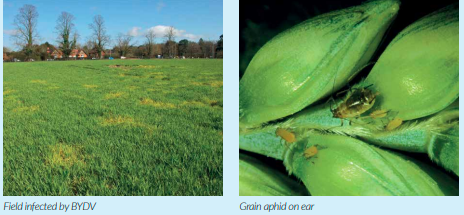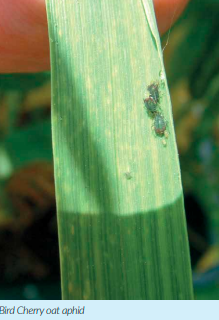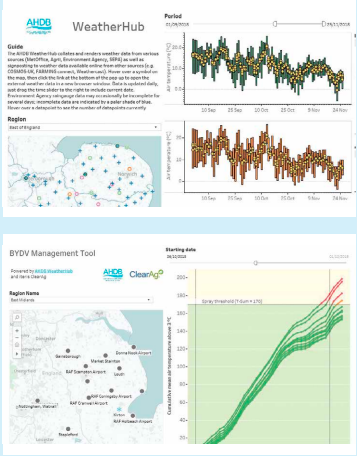Virus-spreading aphids and the risk they pose to winter cereal crops are the subjects of a new management tool and a
research project funded by AHDB.
Barley/cereal yellow dwarf viruses (BYDV) are mainly transmitted by the bird cherry–oat aphid and the grain aphid – via wingless and winged forms. Wingless aphids, which live on grass or volunteer cereals, can colonise the following cereal crop. This ‘green bridge’ can be managed, to various degrees, through cultivations. Winged aphids migrate to newly emerged crops from grass, volunteer cereals or elsewhere. In most years, this infection route stops in November but it can continue throughout mild winters.
Initially, aphids colonise relatively few crop plants. When the second generation offspring are produced, these tend to move away from the plant originally colonised. Consequently, controlling this generation is a key component of a BYDV management strategy. The timing of the second generation can be approximated by accumulating daily average air temperatures above a baseline temperature of 3ºC. It takes around 170 ‘day degrees’ (DD) for the second generation to be produced. To use a simple scenario, daily average temperatures of 20ºC for ten consecutive days – (20ºC – 3ºC)*10 days – equates to 170DD.

As average daily temperatures decrease throughout autumn into winter, earlier drilled crops usually reach the 170DD threshold quicker.
DD calculations should start either:
• On the day of emergence for untreated crops
• When aphids are present and protection from neonicotinoidtreated* seed has run out (around eight weeks after sowing). *Only available for cereals drilled before 19 December 2018
• Following a pyrethroid application (account for product persistence, see label)
Powered by the AHDB WeatherHub, the BYDV management tool features a UK map of weather stations. People can select their nearest weather station (or stations, by selecting a ‘Region’) and select a start date (using the slider) for DD calculations. Once 170DD has been accumulated, the relevant line on the chart displayed enters the yellow zone. At this stage, crops are estimated to be at risk and treatment should be considered. BYDV risk is highest during the early growth stages and passes at GS31.
Prolonged cold periods can also reduce the risk significantly. The BYDV management tool should be used as part of efforts to minimise insecticide use and to manage resistance threats. Grain aphids with moderate levels of resistance to pyrethroids are already widespread in the UK, although effective control should still be achieved at full label rates. At present, there is no evidence of insecticide resistance in bird cherry–oat aphid.
The BYDV Tool
AHDB have released a BYDV management tool (available at: cereals.ahdb.org.uk/bydv) that can be used to predict when the critical second generation aphid offspring (and subsequent generations) are likely to spread through cereal crops. The tool uses air temperatures, from a network of weather stations, to predict when critical second generation aphid offspring is likely to spread through cereal crops. Farmers and agronomists are being asked to use to the tool to both target sprays this season and consider how management might need to change in 2019 – when early aphid protection from a neonicotinoid seed treatment will no longer be an option.

New research on BYDV risk
A new research project has also been funded by AHDB to look in more detail at future management of BYDV. The research, which explores in-field aphid monitoring techniques and control approaches, will deliver results by next autumn – when cereals will be drilled without the protection afforded by a neonicotinoid seed treatment. The Game and Wildlife Conservation Trust (GWCT) has been awarded the contract to lead the work.

Commercial and research trials will be used to test infield monitoring approaches. The trials include the use of sticky traps designed to catch winged cereal aphids. The researchers will explore trap designs and placement. Critically, the team will establish any relationship between the number of aphids trapped and the number flying. Observations of BYDV levels in trials will be used to identify or confirm risk factors. Many factors will be investigated, including those relating to landscape characteristics, cultivation approaches and the presence of natural enemies.
Farmers and agronomists will be actively involved in the work, including the provision of trial sites and opinion, to ensure project outcomes are relevant to industry. Charlotte Rowley, AHDB Crop Protection Scientist, said: “Full-rate pyrethroid sprays can provide effective control of aphids but they are becoming resistant. At present, this is limited to moderate levels of resistance in grain aphids. Knowledge about BYDV risk needs to be improved, to make sure sprays are only ever used as a last resort.”
For more information on aphids and BYDV visit: cereals.
ahdb.org.uk/aphids
